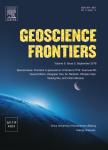Carbon cycle variability in tropical Atlantic across two Early Eocene hyperthermals
Carbon cycle variability in tropical Atlantic across two Early Eocene hyperthermals作者机构:Institute of Groundwater and Earth SciencesJinan UniversityGuangzhou510632China Southern Marine Science and Engineering Guangdong Laboratory(Zhuhai)Zhuhai519082China Department of Earth and Environmental StudiesMontclair State UniversityMontclairNJ07043USA
出 版 物:《Geoscience Frontiers》 (地学前缘(英文版))
年 卷 期:2021年第12卷第2期
页 面:521-530页
核心收录:
学科分类:070903[理学-古生物学与地层学(含:古人类学)] 0709[理学-地质学] 07[理学] 0708[理学-地球物理学] 0704[理学-天文学]
基 金:This study was supported by the National Natural Science Foundation of China(Grant Nos.41976045&41888101)and the Southern Marine Science and Engineering Guangdong Laboratory(Zhuhai)through a group research project(99147-42080024).Y.Cui is supported by the U.S.National Science Foundation award 1603051.Samples and core data were provided by ODP.ODP is sponsored by the U.S.National Science Foundation(NSF)and participating countries under management of Joint Oceanographic Institutions(JOI) Inc
主 题:Early Eocene hyperthermals Oceanic carbonate system Stable carbon and oxygen isotopes Earth system modeling Tropical Atlantic cGENIE
摘 要:Early Eocene hyperthermals are geologically short-lived global warming events and represent fundamental perturbations to the global carbon cycle and the Earth’s ecosystem due to massive additions of isotopically light carbon to the ocean-atmosphere *** serve as ancient analogs for understanding how the oceanic carbonate system and surface-ocean ecosystem would respond to ongoing and future climate ***,we present a continuous carbonate record across the Eocene Thermal Maximum 2(ETM2 or H1,ca.54.1 Ma)and H2(ca.54 Ma)events from an expanded section at Ocean Drilling Program Site 1258 in tropical *** abundant calcareous nannofossils and moderate carbonate content throughout the studied interval suggest this record was deposited above the calcite compensation depth(CCD),but below the lysocline and under the influence of terrestrial *** Earth system model cGENIE is used to simulate the carbon cycle dynamics across the ETM2 and H2 to offer insights on the mechanism of the rapid warming and subsequent recovery in climate and *** model suggests moderate changes in ocean pH(0.1–0.2 unit)for the two scenarios,biogenic methane from a rechargeable methane capacitor and organic matter oxidation from thawing of the *** pH changes are consistent with a recent independent pH estimate across the ETM2 using boron *** carbon emission flux during the ETM2 is at least an order of magnitude smaller than that during the Paleocene–Eocene Thermal Maximum(PETM)(0.015–0.05 Pg C yr^(-1)vs.0.3–1.7 Pg C yr^(-1)).The comparable pre-and post-event carbonate contents suggest the lysocline did not over deepen following the ETM2 at this tropical Atlantic site,indicating spatial heterogeneity in the carbonate system due to strong dilution influence from terrestrial weathering and riverine discharge at Site 1258.



